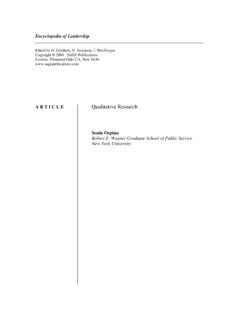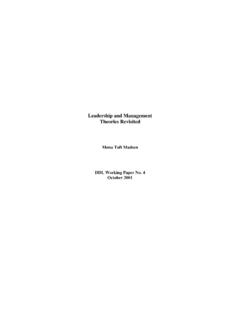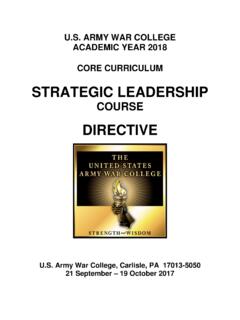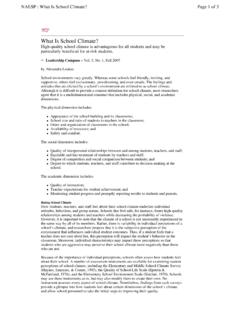Transcription of How Can Leadership Be Taught? Implications for Leadership ...
1 134 How Can Leadership Be Taught? Implications for Leadership Educators This manuscript has been peer-reviewed, accepted, and endorsed by the International Council of Professors of Educational Leadership (ICPEL) as a significant contribution to the scholarship and practice of school administration and K-12 education. Jill Channing East Tennessee State University Whether Leadership can be taught is a decades-long debate. The purpose of this descriptive quantitative research study was to better understand how Leadership is taught and learned. One-hundred-and-thirty-two K-12, college, or university faculty, staff, or administrators responded to a survey questionnaire on Leadership . The majority ( ) of participants who were leaders reported that they felt prepared for Leadership positions. The majority ( ) of participants reported that Leadership can be taught, with only indicating that Leadership is not a teachable skill.
2 Abilities to create positive work environments, communicate to constituent groups, lead change, and supervise personnel were the top-ranked Leadership competencies. Dealing with personnel matters; navigating institutional, local, and state politics; and managing complex budgets were listed as the top challenges leaders face. Participants reported that Leadership can be learned through formal education, mentorship, and Leadership experience. Participants emphasized the importance of human relations and communication skills for leaders. Keywords: Leadership education; mentorship; Leadership learning theories; Leadership competencies; Leadership challenges 135 Some discuss Leadership ability as an innate characteristic (De Neve et al., 2013; McCauley & Velsor, 2004; McMenemy, 2008; Zhihong, Wei, & Xiaoying, 2013). Others contend that Leadership can be learned through a combination of professional development, experience, and mentoring (Antonacopoulou & Bento, 2003; Buchanan, 2017; Elmuti, 2004; Guthrie & Jones, 2012).
3 This researcher argues that Leadership can be taught and that learning and being taught Leadership are not completely synonymous. Being taught Leadership implies that there is a teacher involved in the instruction of an individual or group of individuals while learning Leadership may occur with or without an intentional teacher such as through self-directed research or through work, Leadership , or other experiences. Statement of the Problem Educational leaders and others have described a crisis in Leadership because of the demand for effective leaders and the need for preparation and professional development of those entering Leadership positions in the coming decades (Appadurai, 2009; Zepeda & Ponticell, 2019). While Leadership is much discussed, few researchers have sought to better understand how Leadership is taught and learned, what leaders need to know, what challenges leaders face, and how Leadership professional development influences Leadership practices.
4 This researcher sought to address these gaps in the literature through survey research. Purpose of the Study The purpose of this descriptive quantitative study was to better understand K-12, college, and university faculty, staff, and administrators perceptions of how Leadership is taught and learned in order to develop Implications for educational Leadership educators and programs. The goals of this descriptive quantitative research study were (1) to better understand how Leadership is taught and learned, (2) which Leadership competencies are most important, (3) what significant challenges leaders face, (4) how Leadership education manifests itself in Leadership practice, and (5) what leaders need to know and be able to do. Research Questions The following questions guided this descriptive quantitative research study: (a) What do K-12, college, university faculty, staff, and administrators perceive as essential abilities and knowledge for educational/organizational leaders?
5 (b) To what extent do participants report that Leadership can be taught? (c) What are participants perceptions of Leadership learning and teaching? (d) What major Leadership challenges do participants perceive? (e) How does Leadership education manifest itself in Leadership practices? (f) What professional development types and topics do participants report as needed for effective Leadership training? Significance of the Study This topic is relevant to many fields such as business and education because of the demand for qualified and effective educational leaders in the coming decades (Elmuti, 2004; Elmuti, Minnis, & Abebe, 2005; McMahone, 2012; Young et al., 2018). The critical goal of better preparing educational leaders is to serve effectively students, faculty, staff, and the public. This study s 136 findings have Implications for educational Leadership and Leadership programs as well as for aspiring and current leaders.
6 The researcher makes recommendations for Leadership educators to enhance Leadership professional development based on survey feedback and theoretical conceptualizations of Leadership learning. Limitations and Delimitations This study s participants were limited to those working as faculty, staff, and administrators in K-12, college, and university organizational settings. The researcher sought a purposeful sample, and results may not be generalizable to all populations. Many administrators participated in this survey, which also influenced this study s findings as administrators may have unique perspectives that may or may not be similar to subordinates views of Leadership and the teaching and learning of Leadership . Nevertheless, this study s findings offer applicable insights for leaders, Leadership educators, and educational Leadership program administrators.
7 Review of the Literature Can Leadership Be Taught? There is sparse scholarly literature on the topic of the effectiveness of teaching Leadership (Elmuti et al., 2005; Keating, Rosch, & Burgoon, 2014; Rosenbach, 2003; Rymsha, 2013; Zimmerman-Oster & Burkhardt, 1999). Some researchers even suggest genetic factors related to Leadership skills and roles, unrelated to being taught Leadership (Arvey, Zhang, & Avolio, 2007). While research in this area is scant, editorializing on this topic is not (Allio, 2005; Daloz Parks, 2005; DeRue, Sitkin, & Podolny, 2011; Frohman & Howard, 2008; Howard, 1992; Ryan, 2016; Vecchio, 2004). Gunn (2000) wrote, Can Leadership be taught? Most people would answer this with a firm No! But they might have a hard time explaining why this negative response seems to come so naturally (p. 15). Many people, including Leadership educators and leaders, have feelings about what good Leadership is, how to teach people Leadership skills, and how Leadership is learned.
8 Doh (2003) reported on interviews he conducted with Leadership educators, asking them the question, can Leadership be taught? Participants reflected little diversity demographically or in thought. Doh interviewed no women educators, and he may have drawn richer conclusions by consulting women and men actually in Leadership positions rather than those whose aim was already to teach Leadership . Rymsha (2013) used Kouzes and Posner s (2003) framework for effective Leadership , without an analysis or evaluation of the appropriateness of the framework, to structure her analysis of a corporate Leadership program. Kouzes and Posner s Leadership framework is outlined in their popular Leadership text The Leadership Challenge and is based on the authors collection of case studies. Keating et al. (2014) sought to measure Leadership capacity in students by using pre- and post-tests for a Leadership theory course.
9 Reporting that students learned Leadership with significant findings, the researchers grouped students in high-, median-, and low-scoring groups to measure differences in pre- and post-test scores rather than reporting on and analyzing the significance of the differences in the total sample s scores. Zimmerman-Oster and Burkhardt (1999) found that the Leadership programs they studied produced significant results with participants reporting increased self-understanding, ability to set goals, sense of ethics, willingness to take risks, civic responsibility, multicultural awareness, community orientation, and a variety of Leadership skills (p. 62). How 137 these skills were reflected in these participants work/lives was not mentioned or studied. Hackman and Wageman (2007) suggested a need for the type of research presented here: For all of the research that has been conducted on the topic of Leadership , the field remains curiously uninformed.
10 Yet, there are no generally accepted definitions of what Leadership is, no dominant paradigms for studying it, and little agreement about the best strategies for developing it and exercising it. (p. 43) The present study sought to address these gaps in the literature through its discussions of findings on Leadership teaching, learning, knowledge, and abilities. Theoretical Framework: Leadership Development The theoretical grounding for this research is underpinned by theories of epistemological development through formal and informal learning experiences. The results from this study and others suggest that Leadership comes from innate personality characteristics and developed skills (Connaughton, Lawrence, & Rubin, 2003; Elmuti et al., 2005; Rosenbach, 2003). Zhihong et al. (2013) suggested that some Leadership skills and traits may not be teachable: some tacit dimensions of Leadership involve different processes to gain commitment to a strategy and vision, or the ability of empowering employees by building relationships and demonstrating confidence with humility that can never be effectively addressed by formal classroom training (p.)

















